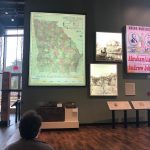Physical Exhibit:
Cyclorama: The Big Picture
Location: Atlanta History Center
Historical Argument
The overarching argument of The Battle of Atlanta 360° Cyclorama Exhibit was clearly displayed on a large screen, the moment visitors set foot on the exhibit space: “there are voices that are not heard”, “arts and entertainment promote myths”, and “The Atlanta History Cyclorama only tells part of the story”.
The physical form of this exhibit created conditions for audiences to activate as agents of their own experiences. The series of effects it generated (elevations and descensions, remoteness and proximities), effectively made audience members both, part of the spectacle (Dabord) seduced once by the cyclorama, and distant observers of that spectacle.
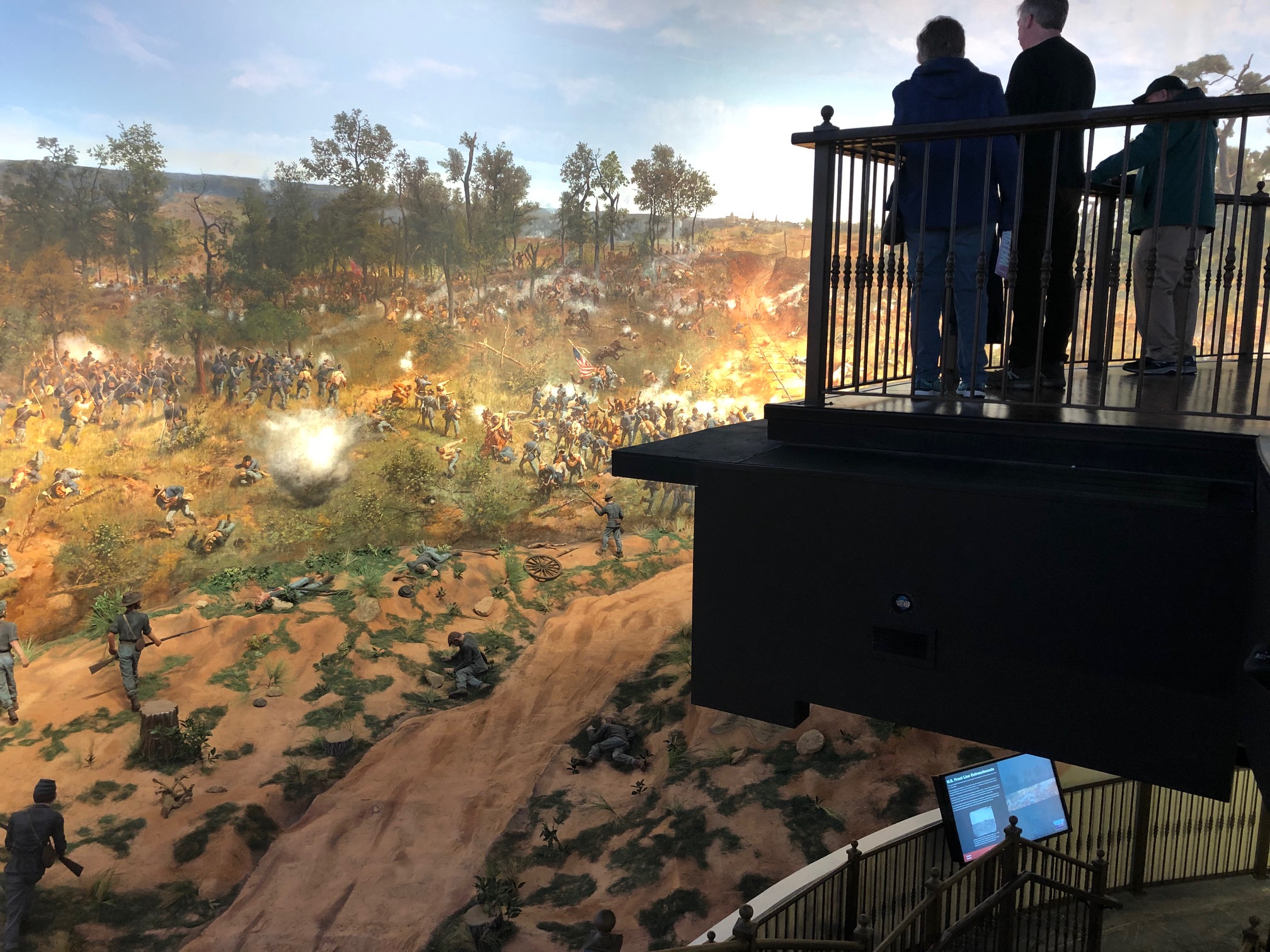
Cyclorama Exhibit (Interior Space). Atlanta History Center. Image Credit: Nashieli Marcano
Audience
The primary audience was described by one of the exhibit’s curators as being diverse and multigenerational, more specifically, one comprised of locals, tourists, students and family groups. It was also indicated the this exhibit went through an audience shift, one that began with locals, and then transitioned into tourists.
The audience present during this observation aligned with the curator’s description. Among the 60+/- participants present, many of them were part of family groups with younger children, older adults with their parents, and a secondary school group of students. Based on the content covered by the docent’s presentation, and the proceeding Q&A session, we could assume that a great number of these were visitors were from out of town.
Items Used for the Exhibit
Primary Items Used to Communicate the Interpretation
The exhibit centered its theme around the cyclorama artifact, a restored cylindrical painting and diorama, combined to depict a specific Civil War event: The Battle of Atlanta. Along with this featured artifact, three other exhibit spaces displayed
The Battle of Atlanta painting covered the whole upper section of the circumference in the room, which forced audience members to move around for better (non-linear) appreciation. The diorama, which covered about 90% of the (lower section) circumference, comprised of restored mannequins resembling fighting and fallen soldiers. The inclusion of a mannequin made to look like the corpse of Gone with the Wind actor, Clark Gable, offered audience members the distancing effect (Brecht) needed to pull themselves out of their temporary immersion (as part of the spectacle) and become cognitive of the legendizing power cycloramas had over the past audiences.
Supports Used to Frame and Contextualize the Materials
The other three exhibit spaces built around the cyclorama structure helped sustain the what you see is only a part of history argument. While these spaces included classic glass display cases featuring artifacts (i.e. artillery, clothing items, letters, and portraits), every now and then, visitors were captured by a wall-sized photograph representing a historical aspect of the Civil War (i.e. Lincoln, slavery). This amplified image provided the frame for other display elements to interconnect: an article of clothing, an image of a newspaper except, and interpretive text that would often include title phrases like “Myth“, or “Fact of Fiction?”.
What could we learn about history perception though the use of an artifact that fictionalized events just to attract audiences?
If audiences stayed cognitive of this premise as they related to these objects, then the exhibit succeeded in facilitating their meaning-making process.
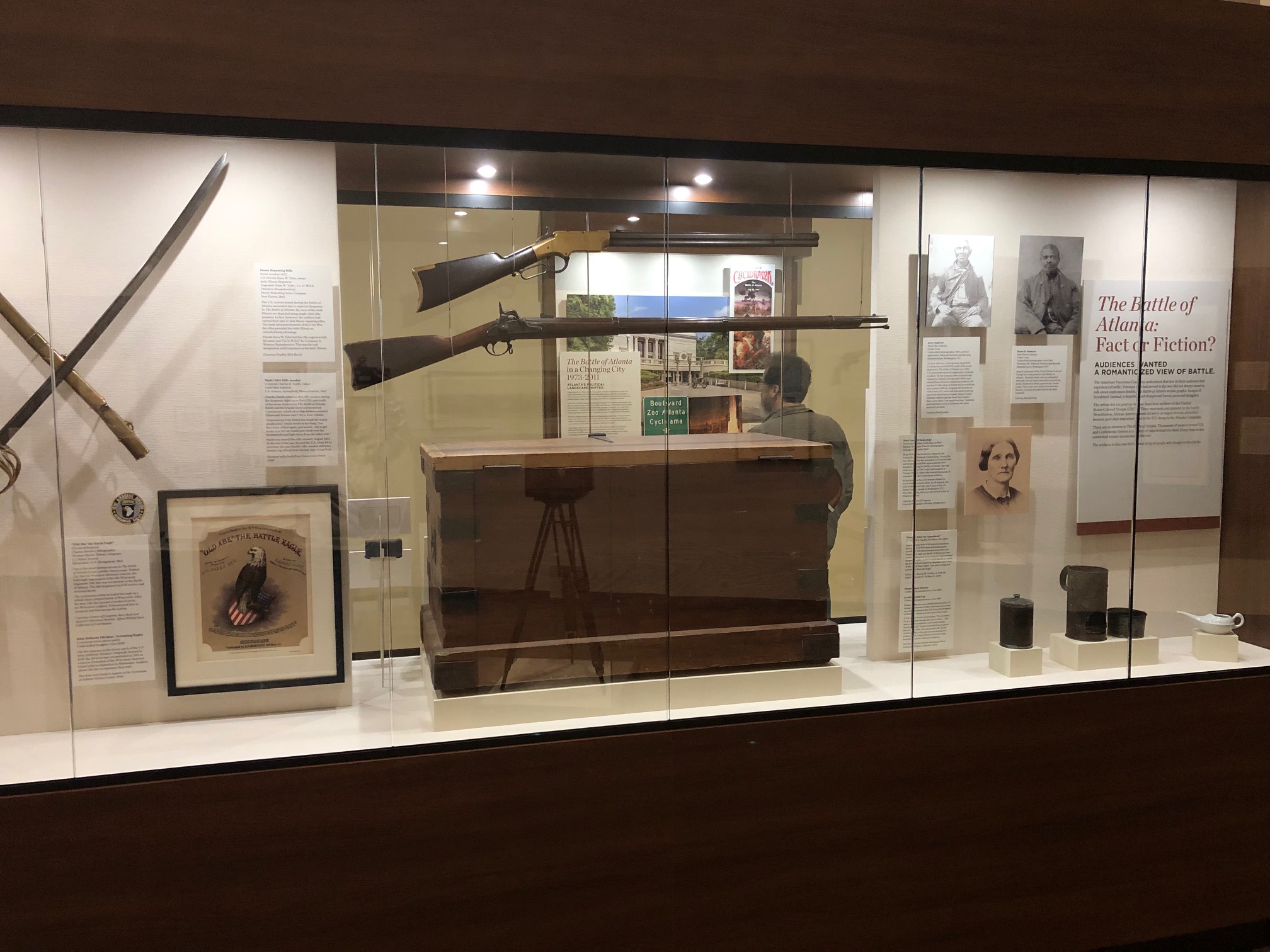
Site Layout
General Description of Layout
This complex exhibit space is comprised of four main sections: (1) the main entrance area (upper level, external to cyclorama structure), (2) the cyclorama space (both upper and lower levels), (3) an exhibit space embedded in the lower level of the cyclorama, and (3) a final exhibit space (lower level, external to cyclorama structure). Due to the physical dimensions of the cyclorama (49’H X 371′ Circ.), a new structure had to be built to accommodate it. The other exhibit areas served as opportunities to appreciate the value of cycloramas as historical artifacts that had shaped publics’ perceptions in the past, just as today’s movies.
Navigation and Flow of Traffic
Based on observations, visitors could navigate all four spaces without difficulty. Other than the scheduled presentation, there was no sequential logic to follow and experience the exhibit, which gave audiences some control over how to approach and relate to the items displayed. Audience flow was determined by (1) signage, and (2) a scheduled presentation on the cyclorama.
Visitors shared one starting point, which was the first exhibit area (upper level, exterior to cyclorama), an area with a couple of impressive displays which introduced audiences to the cyclorama. The flow of traffic did not stop here for long (we’d would see that later it became a final point of re-encounter for some audience members as they exited the exhibit) At this point, there is still a sense of moving as one collective about to have a “shared experience”. Audience members descended to the lower level (there were elevator options), but not without noticing the writing on the stair walls, a series of short facts about the cyclorama. This may have been the exhibit’s way of keeping the audience “grounded” as it was about to enter a spectacular space.
Another spatial experience took place as visitors entered the main as one continuous flow. They walked through a dark passageway, and ascended on an escalator that would lead them to the rotunda, an elevated platform with an “outdoorsy” feeling with privileged views of the artifact.
The cyclorama presentation (a short IMAX-quality film, followed by docent interpretation) was the one place-moment where we felt part of one flow and one “shared experience”. This soon changed after the presentation and Q&A session, as visitors broke down into smaller groups, each moving in different directions.
Interactive Elements of Exhibit
There were a few, effective interactive elements of this exhibit, visitors, there were: electronic timeline displays, touchscreens with interpretive information, a Discover Atlanta: Then and Now e-kiosk, video narrations, and toy-size artifacts (i.e. cycloramas). These moments of interaction were effective in helping audiences gain further Civil War historical knowledge, and to situate the role of the Cyclorama in depicting this historical period.
Although this may not be technically defined as interactive, it is worth noting that the effects produced by the cyclorama presentation has transforming qualities in the way audiences interact with the artifact. As members are asked to get ready (sit down or stand in the back), room gets dark, followed by a heart-pounding, 12-minute film that projects onto the painting itself. This film is a complex, multilayered product that interconnect diverse elements: dark silhouettes depicting cyclorama’s past audiences, historical figures with dueling perspectives on The Battle (i.e. racial, generational, political), fragments of historical sources (i.e. letters, newspaper articles), and a narrated evolution of this traveling cyclorama as it makes its way to Atlanta.
Personnel Presence in Exhibit Space
The were various levels of interaction between audiences and docents. Two docents directed the flow to the cyclorama space and two or three more were in the rotunda.
The live presentation (after the film) took interactive forms, as the docent guided the audiences around the circumference of the cyclorama space, with a series of zoom-ins and zoom-outs. The zoom-in narrative combined a historical fact related to that section of the painting or diorama and a myth-busting fact. The zoom-out moments were about (1) pointing audience members to other exhibit areas for further exploration, and (2) situating them back to a bird-eye view of today’s Atlanta, using the painting as a map and pointing to local visiting spots (i.e cemeteries, historical markers, restaurants, etc,). This could be their way of prolonging the exhibit experience and the meaning-making process.
Recommended Changes to Improve Exhibit’s Effectiveness
None. At one point after the presentation, I asked a docent about typical audience reactions to this exhibit. Part of his answer was: “It depends on the person, and what that person brings to this place. Whether you are school kid or a veteran, whatever you bring in, that will be your lenses for interpretation.” I kept thinking about is response, especially after the cyclorama presentation ended, and audience members were free to go. While some stayed at the rotunda, others walked around the other exhibit areas. Even after 90 minutes walking these spaces, I could still recognize most of the folks from the presentation. I heard a visitor call a relative, “Hey, come here, let me ask you this…”; saw high school students in smaller groups, talking (in native German and Spanish), and pointing to diorama mannequins; spotted some visitors by themselves, either watching videos or staring at a wall-sized photograph. Audiences seemed to be engaged in meaning-making, with “whatever they brought in”.
Digital Exhibit
More than Self: Living the Vietnam War
Creator: Atlanta History Center
Historical Argument
The aim of this online exhibit is to honor the service of women and men of the Vietnam War. Due to the magnitude of loss, the sacrifices made, and the consequential effects this war generated, this site offers a collection of stories from Vietnam veterans, as a chance to hear their perspectives and gain a more human insight into this controversial part of history.
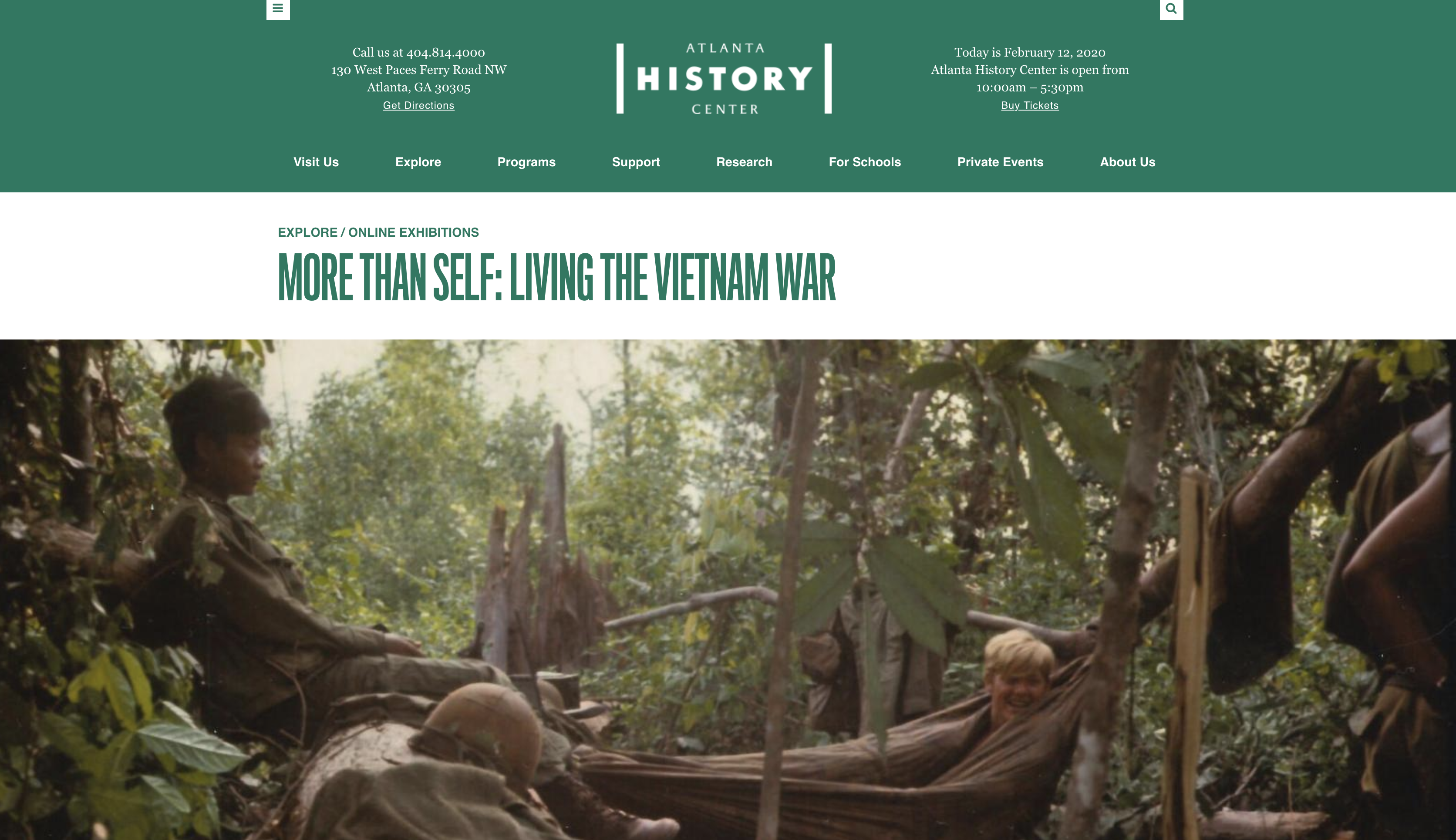
The curation of this online exhibit seems to mirror the physical exhibition that took place at the Atlanta History Center, between November 2017 and March 2018. And it felt that way. Taking aside the fact that the conceptualization of this content took place in the physical space, the More Than Self online exhibit was a successful storytelling exercise that integrated long-form content, images and videos. The design is organized in six themes : First Impressions, Being There, American Involvement, Enemies and Allies, Never Forgotten, and Home.
From the interpretive points of view of these veterans, the Vietnam experience is not defined by combat, but by the everyday living, from the mundane, to the spiritual. To get Vietnam from their point of view, is to shift the attention to the overshadowed aspects of the quotidian (i.e. personal hygiene, playing cards, sitting on hammocks). These stories provide a window to how they were defined by their roles, their relations to the Vietnamese people, their fellow POWs and MIAs; and especially their “home”coming experience.
Audience & Materials Presented
The intended audience is not clearly defined by the site, but based on content and form, it would attract (1) multigenerational veterans, (2) and individuals captivated by the subject of Vietnam. This site would be particularly meaningful to Vietnam veteran themselves and families, looking for ways to commemorate their sacrifices and to leave a legacy.
Both content and interface succeeded in painting empathetic portraits of veterans from a war that, in many ways, condemned them for life. Storytelling became these soldiers’ mechanism to reanimate their memories. One would assume–and hope–that, for many of these storytellers, this recounting their experiences brought catharsis of an unresolved past.
Content Used for the Exhibit
Each one of the six exhibit pages included: an essay-style narration; digitized photographs depicting artifacts or soldiers engaging in daily activities, videos of first-hand accounts of Vietnam veterans, and a MORE menu at the bottom, with thumbnail images that points visitors to other exhibit pages.
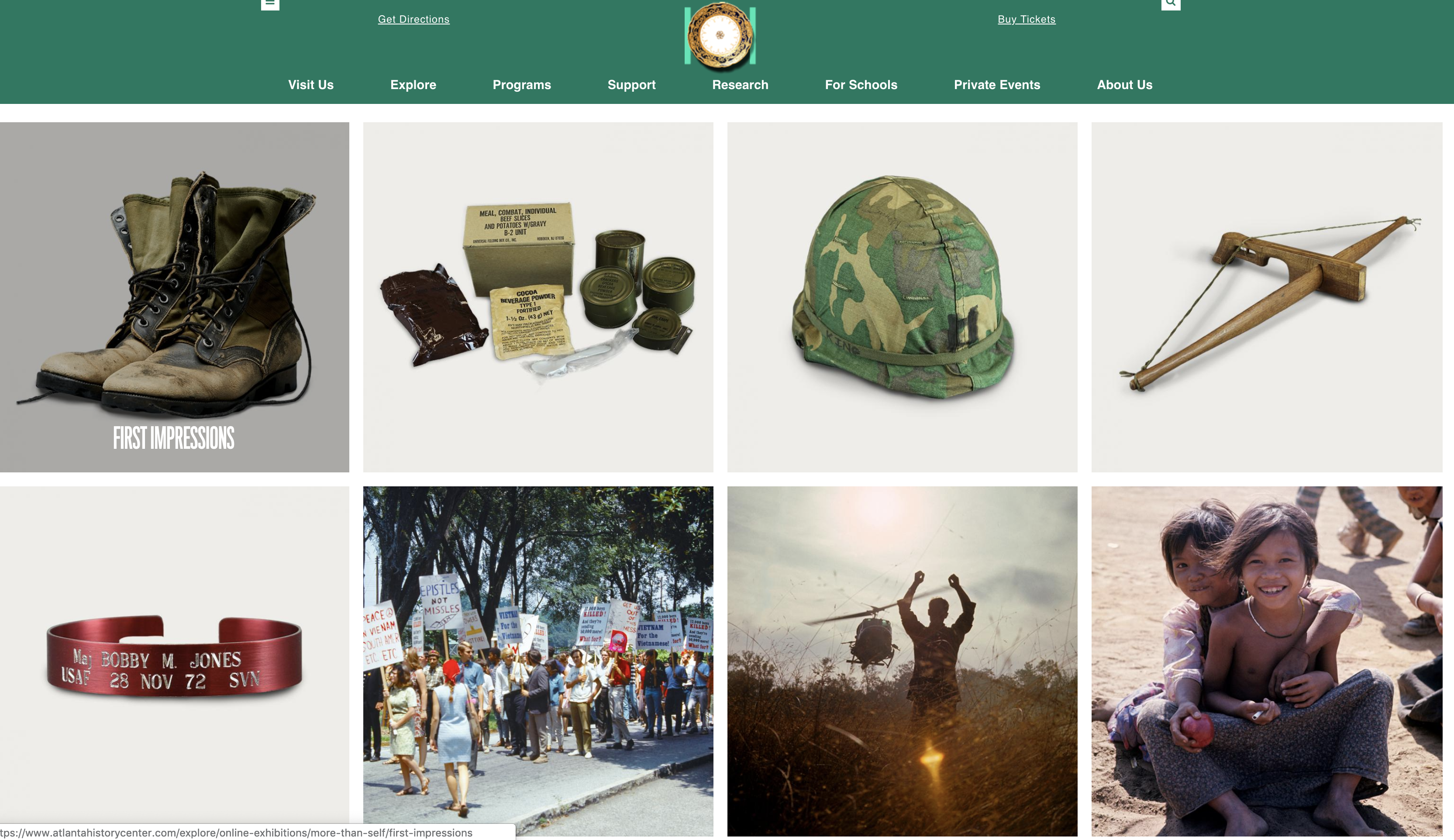
Two main distinctions can be made when comparing the type of items used in the physical and digital venues: (1) the logic in which they are presented, and (2) the way visitors relate to items as they try to make meaning. Except for the cyclorama presentation, most of the physical exhibit space did not dictate the flow to appreciate the artifacts. Whereas the items presented in the online exhibit, visitors can choose which theme to explore, but once they are in the exhibit page, they pretty followed a typical (top-down) reading sequence. Images used were placed according to what was narrated, and videos of first hand accounts were always appearing at the end. It was perceived as a mediated form of engagement.
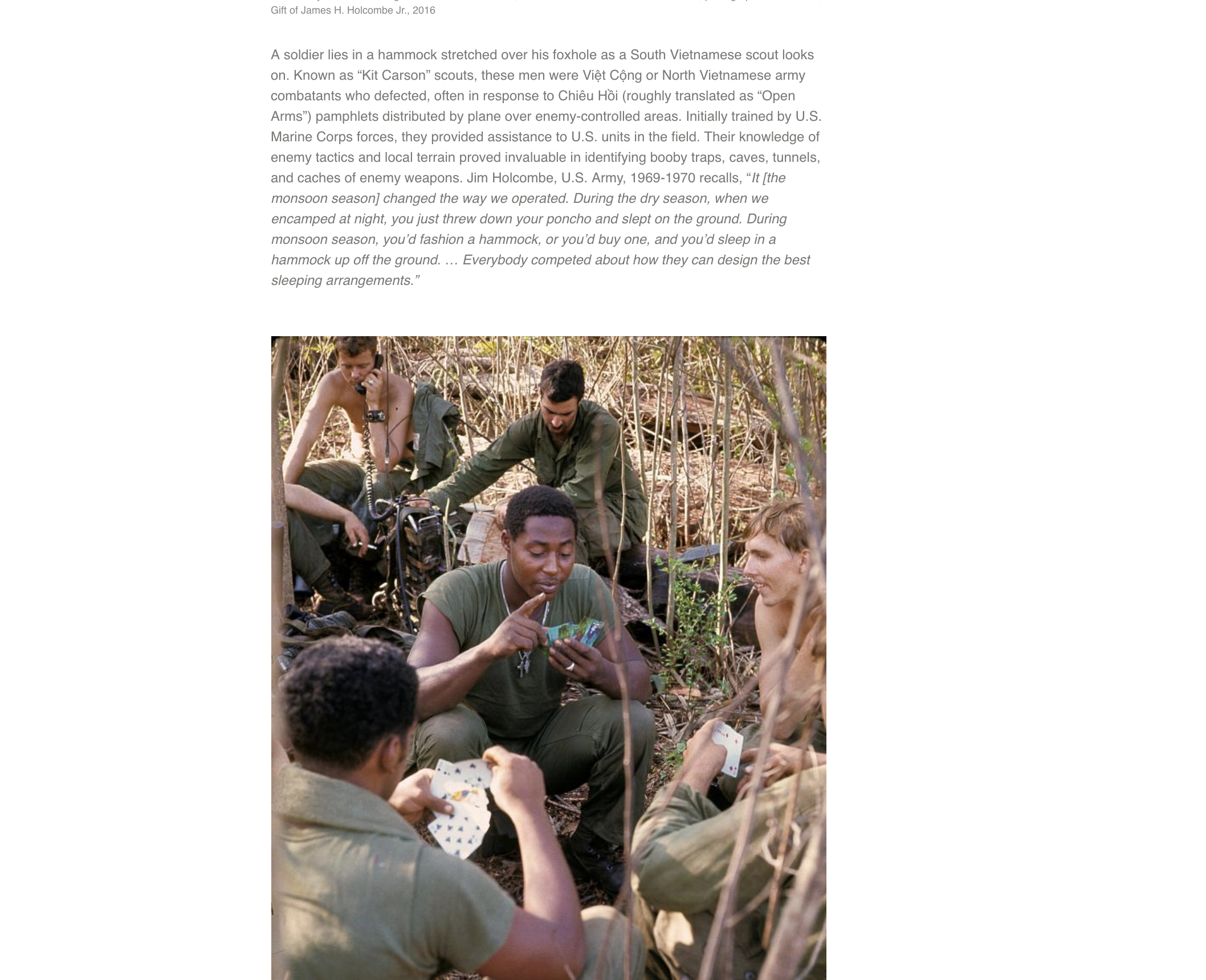
Site Layout and Flow
This site is well organized and easy to navigate, with a couple of options for exploring. While visitors could choose to enter any of the six thematic themes, due to the semi-chronological nature of the exhibit curation, and to long-form styled narratives, traffic flow might have visitors click on the exhibit icons in sequential order. (left-right, up-down).
The Veterans’ History Project section (bottom-right icon) situates the Vietnam stories on the larger context of the American soldier. We are talking of more than 700 oral histories (video and audio interviews) from veterans who served World War II, the Korean War, the Persian Gulf War, and other modern conflicts. This project also preserves documents, artifacts, and other objects belonging to those who had direct military experiences.
Participatory and Interactive Elements of Digital Experience
For visitors of the online site, there are no higher levels of participation and interaction. But for veterans who have not shared their memories with this project, there are opportunities to do so and to be part of a larger oral history community. The site has an open invitation to participate: “It is a legacy only you can leave for your family, friends, and future researchers.” Other than making contact to schedule an interview, there are no other interactive opportunities with site’s creators.
Recommended Changes to Improve Effectiveness of Digital Experience
This site seems to be complementary to the physical exhibit, which might explain the absence a “digital experience”. I we were to rethink this virtual exhibit, I would feature many more access points, and pages with more embedded and interrelated content. It would incorporate more interactive elements that can activate users’ sense of discovery, without too much mediation. The presence of tools to enhance interaction with images, maps, and timelines, would offer audiences opportunities to pave their own paths of inquiry.
